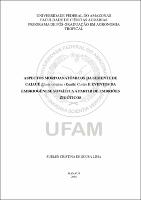| ???jsp.display-item.social.title??? |


|
Please use this identifier to cite or link to this item:
https://tede.ufam.edu.br/handle/tede/6565Full metadata record
| DC Field | Value | Language |
|---|---|---|
| dc.creator | Lima, Suelen Cristina de Sousa | - |
| dc.creator.Lattes | http://lattes.cnpq.br/5361509427463526 | por |
| dc.contributor.advisor1 | Mendonça, Maria Sílvia de | - |
| dc.contributor.advisor1Lattes | http://lattes.cnpq.br/1415829908591701 | por |
| dc.contributor.advisor-co1 | Quisen, Regina Caetano | - |
| dc.contributor.advisor-co1Lattes | http://lattes.cnpq.br/2650765371751663 | por |
| dc.contributor.referee1 | Marcomini, Poliana Roversi Genovese | - |
| dc.contributor.referee2 | Lopes, Ricardo | - |
| dc.contributor.referee3 | Morais, Ronaldo Ribeiro de | - |
| dc.contributor.referee4 | Melo, Maria da Glória Gonçalves de | - |
| dc.date.issued | 2018-01-28 | - |
| dc.identifier.citation | LIMA, Suelen Cristina de Sousa. Aspectos morfoanatômicos da semente de Caiaué Elaeis oleifera(Kunth) Cortés e eventos da embriogênese somáticaa partir de embriões zigóticos. 2018. 85 f. Tese (Doutorado em Agronomia Tropical) - Universidade Federal do Amazonas, Manaus, 2018. | por |
| dc.identifier.uri | https://tede.ufam.edu.br/handle/tede/6565 | - |
| dc.description.resumo | Elaeis oleifera é uma palmeira nativa das Américas cujo óleo da polpa do fruto contém elevadas quantidades de ácidos graxos insaturados. As pesquisas com a espécie são motivadas, principalmente, pelo interesse em genes que conferem resistência a pragas e doenças e reduzido crescimento vertical do estipe para uso no melhoramento genético do dendezeiro (Elaeis guineensis), principal fonte mundial de óleo vegetal. O cultivo de híbridos entre essas espécies (HIE OxG) é realizado principalmente pela resistência desse material a anomalia denominada -amarelecimento fatal- do dendezeiro, presente no caiaué e transmitida aos híbridos F 1 . A propagação de Elaeis oleifera é realizada por sementes que exigem procedimentos para superação da dormência para obtenção de alta e uniforme taxa de germinação. Conhecer as estruturas das sementes bem como os compostos estruturais é importante para entender o processo da germinação. Após coleta das sementes realizou-se observações, descrevendo a forma, coloração e textura. O estudo anatômico foi feito pelo método de inclusão em resina. Foram aplicados testes histoquímicos para detecção dos principais metabólitos. As sementes apresentaram variação biométrica e morfológica com conteúdo proteico e lipídico. Embrião é reto, em posição apical, pequeno, com polo radicular indiferenciado e polo caulinar com três primórdios foliares. O estudo morfoanatômico e histoquímico da semente de Elaeis oleifera identificou características importantes para entender e otimizar o processo germinativo da espécie, fornecendo subsídio para o desenvolvimento de novos métodos de germinação, necessário para a manutenção e conservação de progênies da espécie na condução de programas de melhoramento genético e produção de sementes híbridas. | por |
| dc.description.abstract | Elaeis oleifera is a. native palm in the Americas whose fruit pulp oil contains high amounts of unsaturated fatty acids. Research on the species is mainly motivated by the interest in genes that confer resistance to pests, diseases and reduced vertical growth of the sprig to use in the genetic improvement of the oil palm (Elaeis guineensis), the world's leading source of vegetable oil. Hybrid cultivation among these species (HIE OxG) are carried out mainly by the resistance of this material to the anomaly called Fatal yellowing of the oil palm, present in the Caiaud and transmitted to F1 hybrids. The propagation of the Caiaue is performed by seeds that require procedures to overcome dormancy to obtain a high and uniform germination rate. Knowing the structure of seeds as well as the structural compounds is important to understand the germination process. After the seeds were collected, observations were made, describing the shape, color and texture. The anatomical study was done by the inclusion method in resin. Histochemical tests were performed to detect the main metabolites. The seeds showed biometric and morphological variation with protein and lipid content. Embryo is straight, apical, small, with protein and lipid contents, undifferentiated poles and three-leaf poles. The morphological and histochemical study of the Elaeis oleifera seed identified important characteristics to understand and optimize the germination process of the species, providing subsidy for the development of new germination methods, necessary for the maintenance and conservation of the progenies of the species in the conduction of breeding programs and production of hybrid seeds. | eng |
| dc.description.sponsorship | FAPEAM - Fundação de Amparo à Pesquisa do Estado do Amazonas | por |
| dc.format | application/pdf | * |
| dc.thumbnail.url | https://tede.ufam.edu.br//retrieve/23390/Tese%20Suelen%20Lima%20Final.pdf.jpg | * |
| dc.language | por | por |
| dc.publisher | Universidade Federal do Amazonas | por |
| dc.publisher.department | Faculdade de Ciências Agrárias | por |
| dc.publisher.country | Brasil | por |
| dc.publisher.initials | UFAM | por |
| dc.publisher.program | Programa de Pós-graduação em Agronomia Tropical | por |
| dc.rights | Acesso Aberto | por |
| dc.rights.uri | http://creativecommons.org/licenses/by-nc-nd/4.0/ | - |
| dc.subject | Morfologia | por |
| dc.subject | Anatomia | por |
| dc.subject | Palmeira | por |
| dc.subject | Calogênese | por |
| dc.subject.cnpq | CIÊNCIAS AGRÁRIAS: AGRONOMIA | por |
| dc.title | Aspectos morfoanatômicos da semente de Caiaué Elaeis oleifera(Kunth) Cortés e eventos da embriogênese somáticaa partir de embriões zigóticos | por |
| dc.type | Tese | por |
| Appears in Collections: | Doutorado em Agronomia Tropical | |
Files in This Item:
| File | Description | Size | Format | |
|---|---|---|---|---|
| Tese Suelen Lima Final.pdf | 5.67 MB | Adobe PDF |  Download/Open Preview |
This item is licensed under a Creative Commons License





